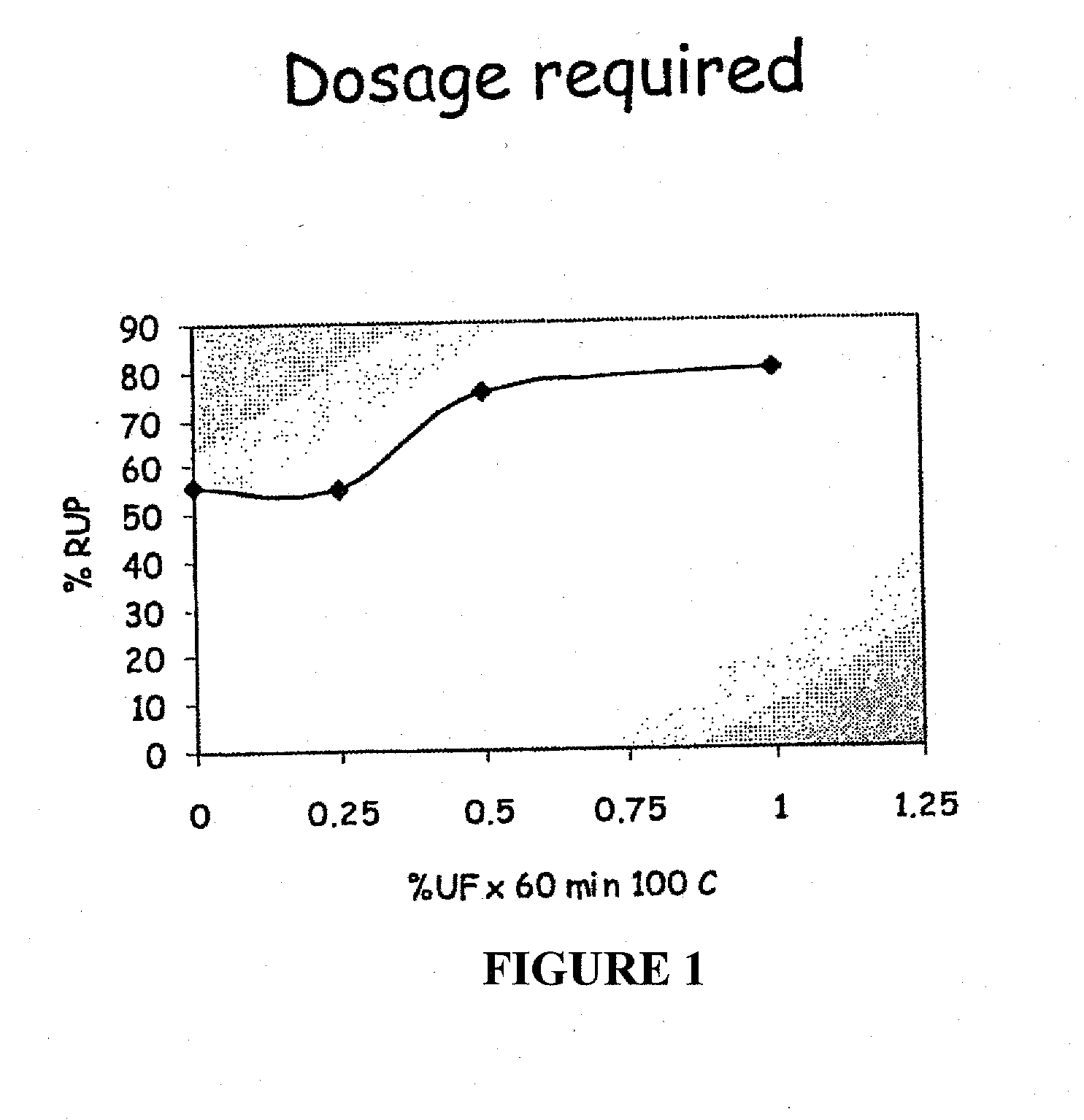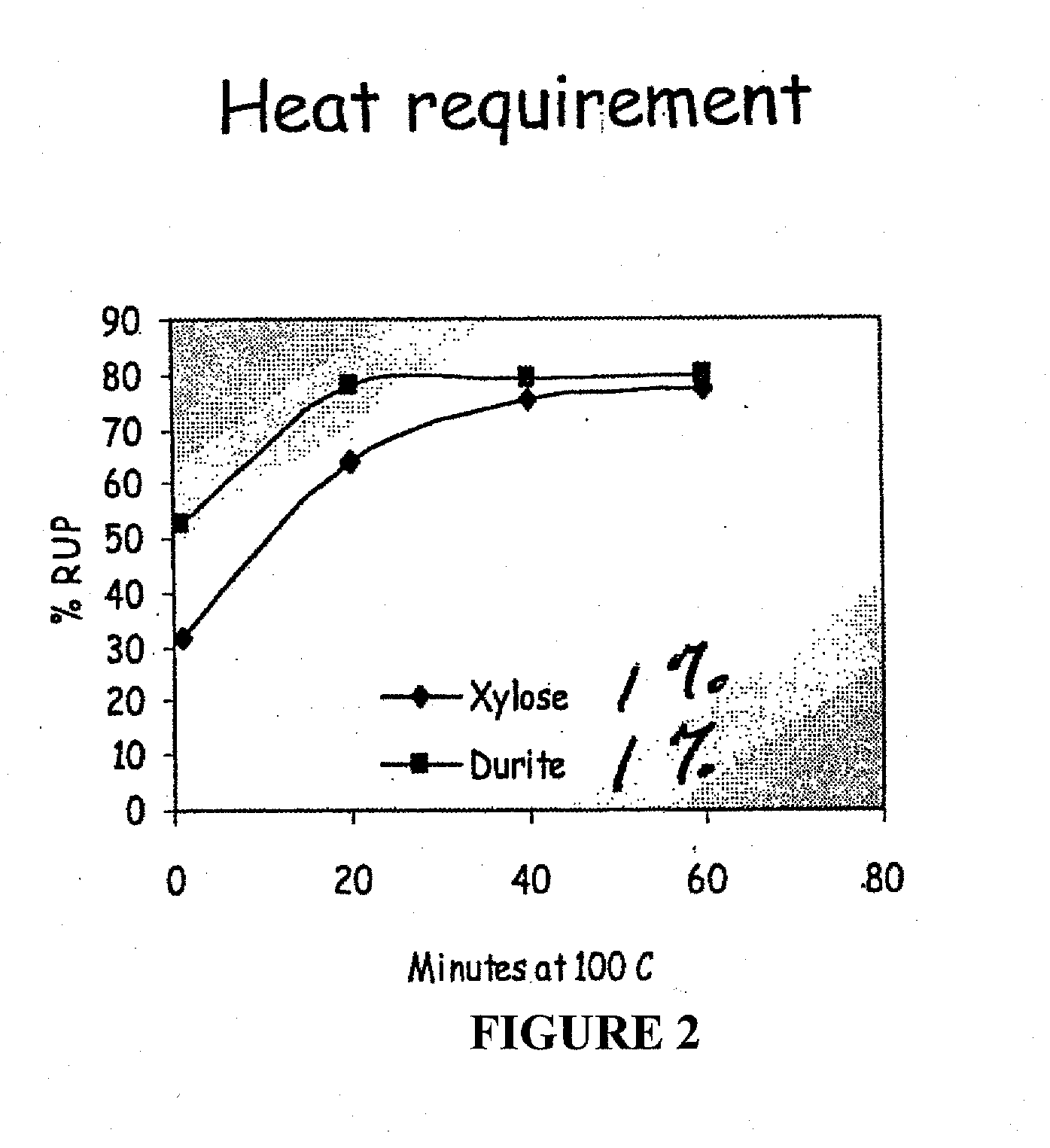Bypass Protection for Protein and Starch in Animal Feed
a technology of animal feed and protein protection, applied in the field of livestock feed, can solve the problems of difficult to effectively use formaldehyde, subject to irreversible oxidative condensation, and not widely commercialized, and achieve the effect of superior economical feed and method of feeding animals
- Summary
- Abstract
- Description
- Claims
- Application Information
AI Technical Summary
Benefits of technology
Problems solved by technology
Method used
Image
Examples
example 1
[0068]Solvent extracted soybean meal was sieved to a particle range for testing with diameters between 0.8 and 1.7 millimeters. A portion was set aside without any treatment to act as a negative control (Control). A second portion was combined with a xylose rich lignosulfonate (Xylig™) such that the Xylig™ comprised 5% of the dry matter of the mixture and provided approximately 1% xylose. Prior to mixing, sufficient water was added to the Xylig™ to take the total moisture content of the final mixture to 20%. The mixture was placed in a covered beaker, heated rapidly in a microwave oven to approximately 95° C., and then transferred to a 105° C. convection oven for 60 minutes. The resulting dark brown (Maillard reaction) material was spread on paper to cool and dry. This non-enzymatically browned soybean meal (NEBSBM) was the positive control. A third portion was treated in a similar manner except Xylig™ was replaced by Durite AL3029R™, a liquid polycarbimide produced by Borden Chemic...
example 2
[0071]Samples were prepared as in Example 1 with the exception of the treatment agents used. Group 1 was a positive control consisting of three different lots of SoyPass™, a non-enzymatically browned commercially produced bypass soybean meal. Group 3 was a second positive control consisting of laboratory samples treated with 5% Xylig™. Xylig™ is a xylose-rich lignosulfonate that contributes approximately 1% xylose and contains no nitrogen. Treatment method was as in Example 1 except that pH of the Group 3 mixture was raised above by addition of caustic. Group 2 was treated with 1% and 2% Durite™ in place of 5% Xylig™. This example shows that use of Durite™ in place of Xylig™ once again gave similar RUP levels with increased crude protein.
TABLE BEffectiveness of 1 and 2% Durite ™CP, %RUP, %GroupSample I.D.Commentof DMof CP1NOPA 99284SoyPass ™51.478.9NOPA 99609SoyPass ™52.379.9NOPASoyPass ™51.575.11002722399-94-E1% Durite ™55.081.5399-94-F2% Durite ™56.285.33399-94-B2RXylig ™, pH51.98...
example 3
[0072]Samples were prepared as in Example 1. Durite™, applied at 0.25, 0.5, and 1.0 percent, was the sole treatment agent. Results indicate that 0.5% Durite™ is nearly as effective as 1.0 percent.
TABLE CEffectiveness of low levels of Durite ™CP,RUP,I.D.Description% of DM% of CP399-100-0.25%52.452.113Durite ™399-100-0.5%52.975.714Durite ™399-100-1.0%53.679.612Durite ™
PUM
 Login to View More
Login to View More Abstract
Description
Claims
Application Information
 Login to View More
Login to View More - R&D
- Intellectual Property
- Life Sciences
- Materials
- Tech Scout
- Unparalleled Data Quality
- Higher Quality Content
- 60% Fewer Hallucinations
Browse by: Latest US Patents, China's latest patents, Technical Efficacy Thesaurus, Application Domain, Technology Topic, Popular Technical Reports.
© 2025 PatSnap. All rights reserved.Legal|Privacy policy|Modern Slavery Act Transparency Statement|Sitemap|About US| Contact US: help@patsnap.com


